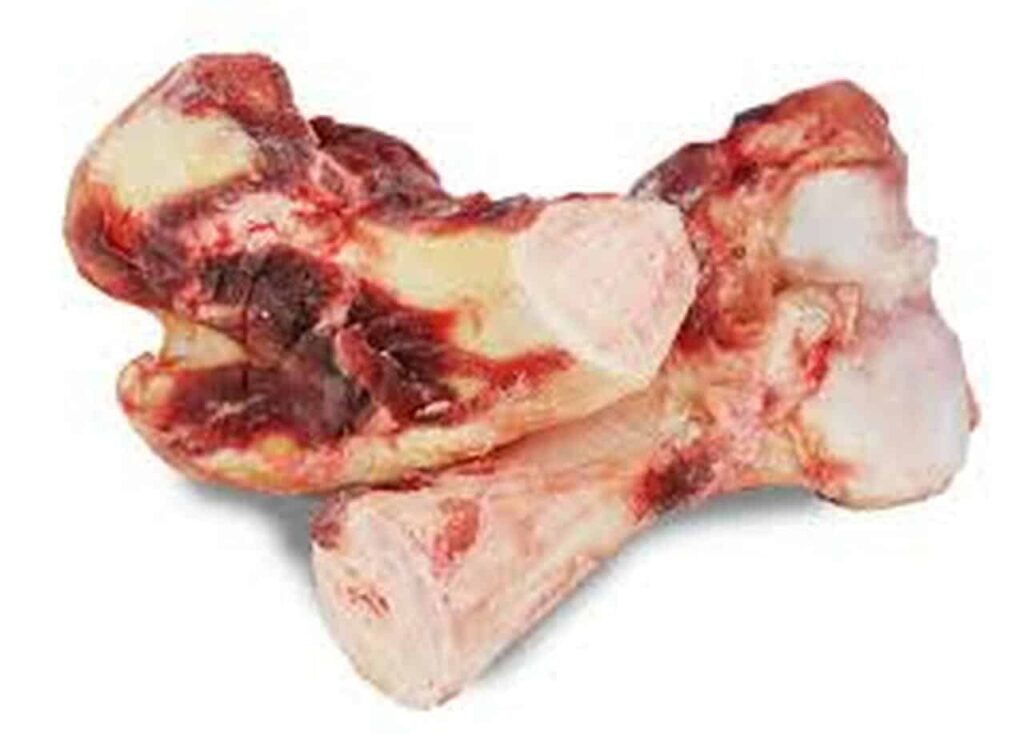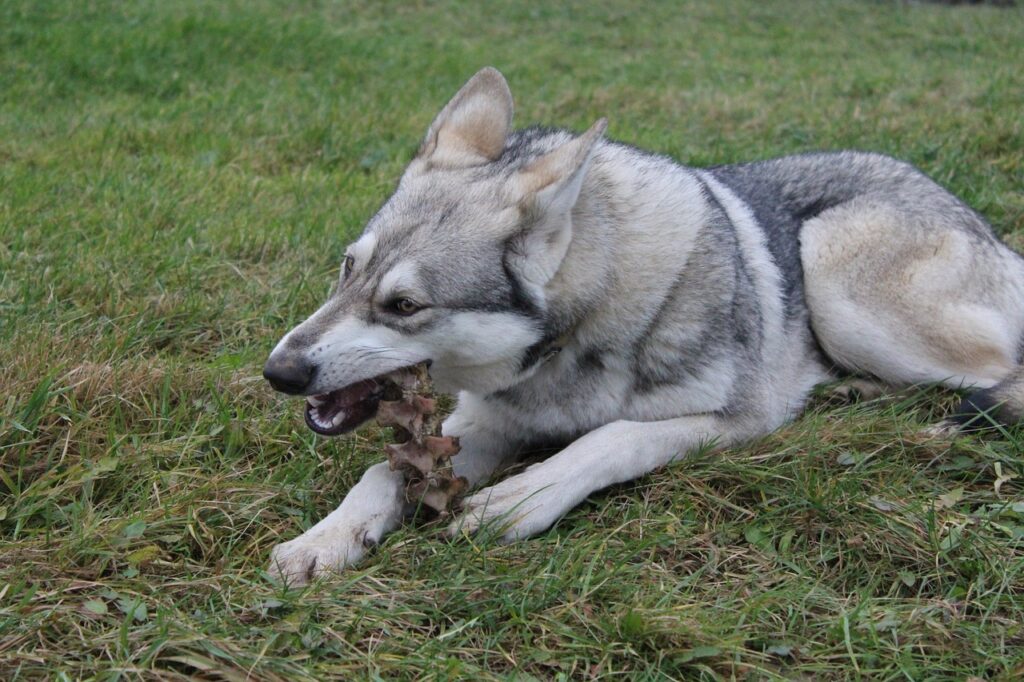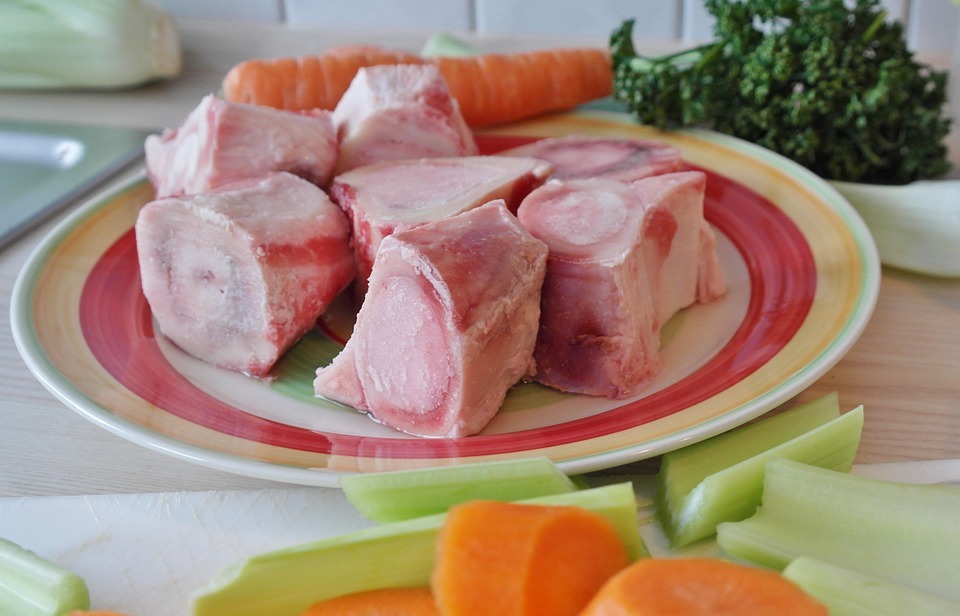I bet you have come across cross conflicting opinions regarding whether or not giving your dog bone treats is safe in the first place.
Well, marrow bones are good for dogs to chew. Considering that these bones are delicious, all-natural with no preservatives, they not only improve the overall health of your dog but they are also great for your dog’s dental health.
In particular, the bones help keep your dog’s teeth clean and exercise the muscles of their jaws. They also scrape away tartar and plaque when your pup chews on them, promoting healthier teeth and gums)
Bones are also rich in glucosamine and chondroitin, compounds that are known to promote joint health and stave off arthritis in dogs. They also contain zinc, magnesium, and selenium, which boost immunity.
However, marrow bones should be consumed in moderation as they can be dangerous to your pup. According to the American Veterinary Medical Association, raw bones can cause intestinal obstruction, gastroenteritis, and fractured teeth.
When dogs chew marrow bones vigorously, the bones can get stuck on their lower jaws. This can easily break your dog’s tooth. Dogs can also choke on bones or ingest them.
To keep your dogs safe, make sure you monitor your dog when chewing and only give the dog frozen beef marrow bones which are less hard.
You should then discard the bone once your dog has chewed the bone marrow. This is because as the bone gets dry, it becomes harder and more brittle, making it more likely to break and harm your dog.
You should also serve your pups with sizeable marrow bones.
Large bone marrows should be avoided as they can fracture your dog’s teeth while small ones can be swallowed easily.
Raw or Cooked Marrow Bones: Which option is better?
Raw marrow bones are always a better choice over cooked options.
Cooking marrow bones dehydrates them, making them more likely to splinter or break easily.
Splintered bones are more likely to puncture your pup’s intestinal organs and lead to nasty and life-threatening complications.
Cooked bones also hold less nutritional value as raw bones.
If you are concerned about the safety of giving your canine friend a marrow bone, you can use the bone to prepare broth that a dog of any age will enjoy. We’ll show you how to go about it shortly.
Sourcing and Preparing Marrow Bones for Dogs

First…
Before cooking marrow bones, you need to know where to buy marrow bones and how to purchase the best.
Local butchery or raw food co-op is the first place dog parents turn to.
You can also purchase marrow bones from Amazon.
One good thing about bone for dogs from Amazon is that retailers on the platform have done the hard work of choosing the best bones for your dog.
Some of the bones that they stock have also been professionally roasted for better taste and maximum nutrition for your dog.
Check out this post for the best smoked bones for dogs on Amazon right now: Best Smoked Bones for Dogs
Irrespective of where you decide to buy your marrow bones, remember to choose bones that are safe for your dog.
In particular, ensure that the bones are appropriate for your dog’s age and breed.
Let’s explain this a bit:
Age
For puppies, avoid marrow bones from hard-to-chew bones until all the puppy teeth have been replaced with adult teeth.
And if you have a puppy that’s new to the family and you aren’t familiar with his chewing style, consider getting softer marrow bones.
If you have senior or elderly dogs, go for softer marrow bones as well because such dogs often suffer from brittle teeth or worn-out teeth (due to life-long use).
Breed
Medium to large dog breeds like German shepherds, Great Dane, Labradors, Dobermans, etc should be given marrow bones that are large enough so that they don’t chew and swallow them, causing chocking hazards.
Go for Jumbos, cut femurs, and knuckles if you have such dogs.
Things like chicken bones, lamb or pork are too small and brittle for larger dog breeds and should be avoided as they can easily swallow them, causing intestinal blockage.
As a general guide, ensure that the marrow bone you choose for your dog doesn’t fit inside his mouth.
In other words, the marrow bone should be larger than your pup’s muzzle, making it impossible for him to swallow it whole.
Brachiocephalic breeds like bulldogs, Shih Tzu, pugs, and boxers are not physically designed to chew bones safely and effectively.
If you own such dogs, just avoid bone marrow treats altogether. Consider giving them something like a Kong toy as a substitute or bone broth (without bones).
Related Post: Barrel Chest Dog Breeds
Secondly…
The bone should neither have sharp edges nor too small to be swallowed whole.
So, the next step is to ensure that the marrow bone is cut the right way.
If you are going to purchase your marrow bones from a local butchery or food store, we recommend asking your shop attendant to slice for you the marrow bone on the vertical so that each side of the marrow appears like half of a circle.
The vertical cuts not only give a beautiful presentation but are also safe for your dog to chew. Horizontal cuts tend to splinter a lot.
Most importantly, it allows any herb flavors that you include in your recipe to marry the marrow, enhancing more even cooking.
Last but not least, strive to know the age of the animal the bone marrow is derived from.
Avoid bones derived from older animals because the longer an animal lives, the more it gets exposed to environmental toxins.
Do Marrow Bones Need To Be Soaked?
Marrow bones should be soaked for 1-2 days in salted water before they are prepared.
Soaking them in salty water removes the blood and any oil and dead skin cells which would otherwise ruin the taste.
To soak your marrow bone properly, place them in a roomy bowl, cover them with water and add 2 tablespoons of salt.
You can then refrigerate the bones.
For best results, change the water 4-6 times and add fresh salt each time you change the water.
You can then use the bones immediately or you can also freeze them for up to 2 months.
If you soak the bones for less than a day, you may not notice any significant difference.
Also, if you don’t change the water 4-6 times, you will not get rid of the blood and dead skin cells.
So, you have to be patient with the process for the best results.
How to Cook Marrow Bone Broth for Dogs

Ingredients
- 1-2 ( or more) pounds beef marrow bones
- 4 carrots
- ½ cup apple cider vinegar
- 2 ounces chopped parsley
- 2 stalks celery, chopped
- 4 carrots
- Water (enough to cover the marrow bones up to 2 inches)
Process
- Chop all the herbs and vegetables and throw them in your crockpot or slow cooker.
- Next, add the marrow bones and then add water until the bones are covered.
- Add 3 to 4 tablespoons of vinegar.
- Leave it to cook on a high setting of your cooker for about an hour then turn it to low setting and let it cook for 8-24 hours. Remember to top up water from time to time so that the pot doesn’t become too dry.
- Strain the bones and meat out. The bones should not be fed to your dog.
- Cool your broth and remove the layer of fat on top before feeding your dog.
Pro Tips:
-Check out this post for specific bone broth recipes as well as the best store-bought options (in case you want ready, commercial broths)
-Don’t bake raw bones for your dog as it makes them dry and prone to splintering.
How Do You Know When Bone Marrow Is Done?
After salting and freezing your bones, you may want to roast them to enhance the flavor.
Depending on the size of the bones and whether they have been cut lengthwise or crosswise, you will need to roast them on a roasting pan for 15-20 minutes.
You will know the bone marrow is ready when it starts to puff out or when it gets warm at the center.
To test the warmness of the marrow, insert a skewer and push it to the center of your bone and then touch it to your wrist to feel the temperature.
If the temperature is hot, the marrow is well done.
Also, done marrow will not give you any resistance as you push the skewer through.
Are Frozen Marrow Bones Safe For Dogs?

Freezing bones makes them very hard and your dog will most likely crack his teeth as he tries to crack through them.
Besides, old bones could also be laden with bacteria which could result in all manner of health issues.
When bones get too hard, they can easily splinter and those splinters could easily puncture an organ. Cooking the bones has the same effect.
This is why it is best to serve the bones raw—right after treating them in salted water.
Since the treatment involves freezing, make sure the bone thaws first before you give it to your dog.
How Much Marrow Bone Should You Give Your Dog?
Dogs love bones, but that shouldn’t mean that you should give your dog marrow bones every day. Marrow bones can cause potential health problems for your dog.
As such, they should be consumed in moderation. Always give your dog marrow bones as a treat.
At best, limit your bones to 2-3 times a week. You should also keep it to one bone marrow at a go.
If you are giving your dog marrow bone for the first time, introduce it slowly as you assess your pup’s reactions.
If your dog doesn’t show any adverse reaction, then you can work your way up, increasing the quantity depending on your dog’s size.
Related Post: How Much Ground Beef Should I Feed My Dog?
Is Bone Marrow High In Cholesterol?
Bone marrow has been found to have some cholesterol although the amount depends on the type of bone and diet of the animal.
Researchers compared the marrow from the femur, lumbar and cervical bones of cows that were fed on finishing rations versus those that were raised in a free-range system.
The bone marrow of the free-range animals was at an average of 119.6/100g while that of grain-fed animals was averaged at 150.6 mg/100g of marrow.
Additionally, the average cholesterol quantities of femur, lumbar and cervical bones were 91mg/100g, 124.1 mg/100g, and 190.1mg/100g respectively.
From this, we can infer that cholesterol is highest in the bone marrow from the cervical bones of animals that were raised on finishing rations.
Your Dog Vomiting After Eating Marrow Bone: What Should You Do?

If your dog ate too much bone marrow, he might develop an upset stomach and start vomiting. This is because bone marrow contains a lot of fats which when ingested can cause stomach upsets.
There are also other causes of vomiting aside from the excess fats.
Below are some of the most common causes of vomiting and what you should do in each instance.
1. Gastroenteritis
This is stomach inflammation caused by abrupt changes in diet.
Your dog can develop this condition and start vomiting if the dog isn’t used to consuming marrow bones regularly.
In most cases, this condition occurs when you give your dog marrow bones for the first time.
All you have to do is to give your dog time for the inflammation to subside after which you can give him an upset stomach bland diet.
2. Gastro-Intestinal Blockage
Sometimes your dog may swallow a bone, which blocks the passage of food. This implies that the dog will vomit the food after a few minutes or even hours.
If your dog has swallowed a bone, you ought to inspect their stool for the ingested bone.
If you don’t find anything, you should consult a veterinary doctor for medication. In most cases, your dog may require surgery to remove the bone.
3. Vomiting from Bone Fragments
Some bone fragments are not digestible. When your dog ingests them, they settle in the stomach.
Your dog may feel fine, but by midnight or the following day, the dog may start vomiting these fragments.
Sharp fragments can also scrape the lining of the esophagus and cause blood spots.
In cases where the fragments perforate the lining of the abdominal cavity, commonly referred to as peritoneum, you will need to consult a vet immediately. This condition can be life-threatening if not well managed.
Marrow Bone Stuck On Dog Jaw: Should You Be Worried?

It is common to see marrow bones getting stuck on dog jaw.
Most of the time, the bones get stuck on their big teeth (canine), and when the lips swell, the bone gets locked around the jaw.
If this happens, you need not worry. All you have to do is visit a vet for it to be removed.
The veterinary will put your dog under anesthesia before wiggling it out. However, if it fails to come out, the vet will need to saw it off.
You should also rush to the vet if he inhaled the bone and it is now stuck deep in the trachea.
But if he is losing consciousness and cannot breathe clearly (before you reach the vet), perform a Heimlich maneuver on him.
To prevent marrow bones from getting stuck on dog jaws, you should give a bone of the right size to your pet.
Choose large-sized marrow bones for larger breeds and smaller bones for your small dog.
Most importantly, supervise your dog every time you give them a marrow bone for their safety.
Other Tips to Help Your Dog Get the Most of Marrow Bones
- The best time to feed your dog marrow is after meals. If your dog is full, he is less likely to chow down the bone (which could lead intestinal obstruction).
- Know when your pup’s marrow bones are ‘finished’. The goal of feeding your dog marrow bones is to allow him gnaw off marrow, tendons, or other soft tissues and not the whole bone. So, after he has gnawed all the good stuff, consider taking away the bone and replacing it with his favorite toy.
- Closely observe the chewing style of your new puppy to establish whether they are aggressive chewers and whether he is trying to swallow large portions. This way, you will be able to determine the type of marrow bones to buy him in the future.
- If you’ve recently put any dental work (braces or crowns) on your dog, avoid feeding him marrow bones
- Marrow bones are not recommended for dogs with sensitive stomachs (dogs that get diarrhea and upset stomach easily). Since marrow has very high fat content, it may cause the mentioned symptoms (and even pancreatitis) in some dogs, especially those that are not used to richness of the fat.
Parting Thoughts
Treat your dog with some beef marrow bones from your local butchery or Amazon! Bone marrow bones are suitable for your dogs if given in moderation.
Ensure you give your canine friend fresh raw bones which are not brittle. You should also watch your dog while eating the bone to prevent any accidents.
As an Amazon Associate, we may receive a small commission from qualifying purchases but at no extra cost to you. Learn more. Amazon and the Amazon logo are trademarks of Amazon.com, Inc, or its affiliates.

